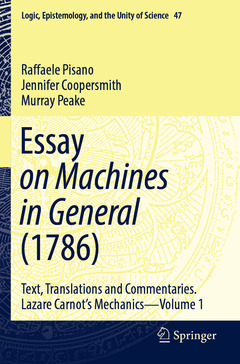Essay on Machines in General (1786), 1st ed. 2021 Text, Translations and Commentaries. Lazare Carnot's Mechanics - Volume 1 Logic, Epistemology, and the Unity of Science Series, Vol. 47
Auteurs : Pisano Raffaele, Coopersmith Jennifer, Peake Murray

This book offers insights relevant to modern history and epistemology of physics,
mathematics and, indeed, to all the sciences and engineering disciplines emerging
of 19th century. This research volume is the first of a set of three Springer books on
Lazare Nicolas Marguérite Carnot?s (1753?1823) remarkable work: Essay on Machines in
General (Essai sur les machines en général [1783] 1786). The other two forthcoming
volumes are: Principes fondamentaux de l?équilibre et du mouvement (1803) and
Géométrie de position (1803).
Lazare Carnot ? l'organisateur de la victoire ? in Essai sur le machine en général (1786)
assumed that the generalization of machines was a necessity for society and its economicdevelopment. Subsequently, his new coming science applied to machines attracted
considerable interest for technician, as well, already in the 1780?s. With no lack in
rigour, Carnot used geometric and trigonometric rather than algebraic arguments, and
usually went on to explain in words what the formulae contained. His main physical?
mathematical concepts were the Geometric motion and Moment of activity?concept of
Work . In particular, he found the invariants of the transmission of motion (by stating
the principle of the moment of the quantity of motion) and theorized the condition of
the maximum efficiency of mechanical machines (i.e., principle of continuity in thetransmission of power).
While the core theme remains the theories and historical studies of the text, the book
contains an extensive Introduction and an accurate critical English Translation ?
including the parallel text edition and substantive critical/explicative notes ? of Essai
sur les machines en général (1786). The authors offer much-needed insight into the
relation between mechanics, mathematics and engineering from a conceptual, empirical
and methodological, and universalis point of view. As a cutting?edge writing by
leading authorities on the history of physics and mathematics, and epistemological
aspects, it appeals to historians, epistemologist?philosophers and scientists (physicists,mathematicians and applied sciences and technology).
Date de parution : 02-2022
Ouvrage de 352 p.
15.5x23.5 cm
Date de parution : 02-2021
Ouvrage de 352 p.
15.5x23.5 cm
Disponible chez l'éditeur (délai d'approvisionnement : 15 jours).
Prix indicatif 137,14 €
Ajouter au panierThèmes d’Essay on Machines in General (1786) :
Mots-clés :
History of Science, Mechanics-Mechanism, Relationship Physics-Maths-Mechanics, Relationship Philosophy-History-Epistemology, Epistemology of Science, Principles, Theorems, Philological, Methaphysical and Philosophical Insights, Essay upon Machines in General (1796), Fundamental Principles of Equilibrium and Motion (1803), Geometry of Position (1803), Lazare Carnot's Works, First Law of Thermodynamics and its General Energy Conservation, Essai sur les Machines en Général, Réflexions sur la Métaphysique du Calcul Infinitésimal, Principes Fondamentaux de L’équilibre et du Mouvement



